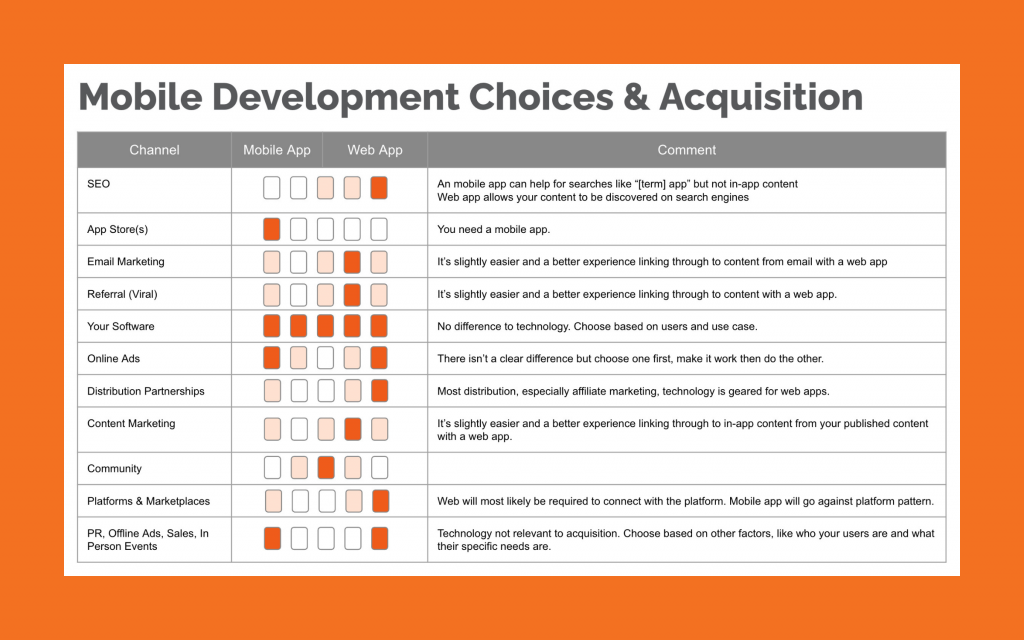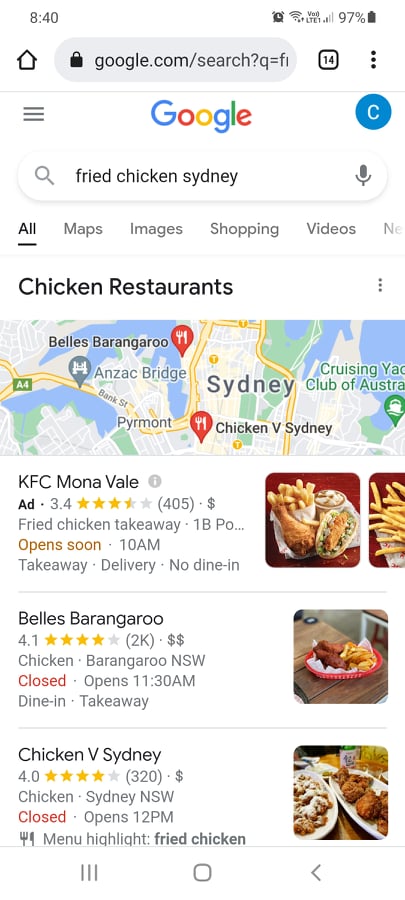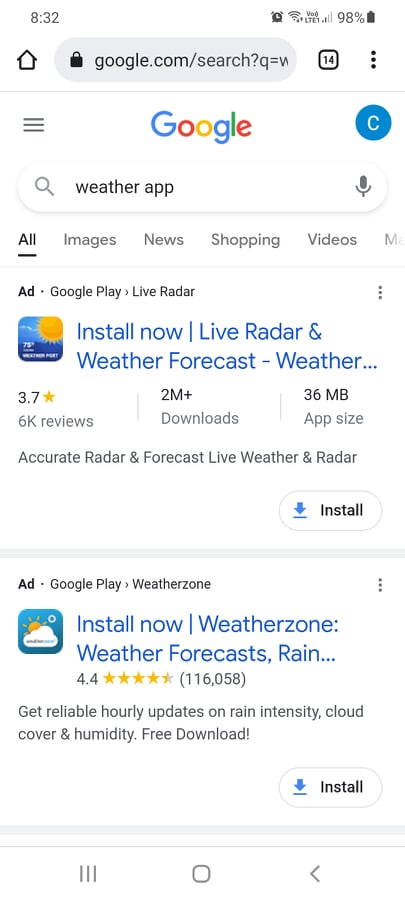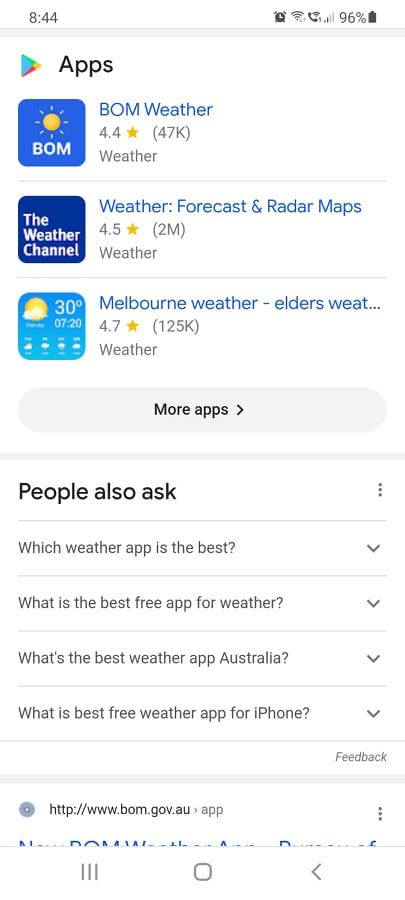
In the world of mobile, the method you choose to build your mobile app will impact how well it works with users signing up via different acquisition channels – especially new users. In some cases, development and technology choices may even stop you from using certain acquisition channels.
So, now you need to understand upfront how you can expect to acquire users. This will ultimately feed into your decisions about which path to take for mobile development.
Please note, this post is about looking at the different channels to acquire mobile users and assessing which mobile development and technology options best fit each channel. It’s not about explaining or assessing the channels themselves in detail.
To ensure every possible acquisition channel is covered, the below comprehensive list of acquisition channels from the book Traction has been used as a basis. The list consolidated list from Traction has been slightly modified to better fit this analysis of technology choices.
The acquisition channels you will want to assess your mobile technology choices against, in rough order of relevance to mobile, are:
- Search Engine Optimisation (SEO)
- App Stores
- Email Marketing
- Referral (Viral)
- Your Software
- Online Ads (SEM, Social and Display)
- Distribution Partnerships (inc Affiliate Marketing)
- Existing Platform
- Content Marketing
- Community
- Public Relations (PR)
- Offline Ads
- Sales
- In-Person: Trade Shows, Physical Events, Speaking
Acquisition: In this context acquisition or “acquiring users” refers to getting new users to sign up, install or use your app.
In this table below, is an overview of Terem’s Mobile Development Choice and Acquisitions Channels.

Let’s unpack the details of mobile development against each acquisition channel here:
1. Search Engine Optimisation (SEO)
According to a Google/Ipsos poll from 8,740 people, 1 in 4 users discovers an app through search. In this context, SEO is the practice of optimising and targeting your app and its content towards how people search and how search engines work.
There are two approaches to SEO for mobile:
- SEO for the app
- SEO for the content
Again, SEO techniques are beyond the scope of this article.
1. SEO for the App
Search engines now have the ability to show apps in their search results, like this example of searching for a weather app:
Mobile apps are surfaced above other content whether you’re on mobile or desktop. The only technical requirement is to have a mobile app.
2. SEO for the Content
Search engines are unable to peer into the contents of a mobile app but they can see the contents of a mobile website. When the contents of a mobile website are optimised for search engines, it increases the likelihood of local map rankings.
You can see that the top results come from websites and places entered into Google Maps. Nothing from an app despite the likes of Deliveroo and Uber listing numerous similar results:

This means that if your go-to-market strategy requires new people to find your information or content on a search engine and then to seamlessly start using your product – a mobile website is likely a more appropriate use case. If you build a mobile app people will be unable to discover your content through a search engine and then be able to navigate straight to it (unless you build a mobile website first).
2. App Store(s)
If you are looking to acquire new users through the app store then building natively for the app store’s device is the best choice and maybe the only choice.
Most app stores will not list your app without building specifically for the app store’s devices. By building specifically for their platform you will be discoverable in their store, usually where their users are searching.
It’s best to note that if you see a marketplace, like Salesforce or Atlassian, as your key traction channel then scroll down to the Existing Platforms & Marketplaces section of this article. Since this channel specifically deals with a slightly different approach to the App Store channel.
3. Email Marketing
Email Marketing is where you plan to use your existing email list or one that you acquire to promote your mobile product and experience to install. If people are directed to just the mobile product itself to use then there is little difference between a mobile web or an installable mobile app.
The difference in development and technology comes when linking to specific content. If your app has specific content that can be tailored to suit a target audience, then you will need the capability to send varied targeted messages for them to take action. For example, I might not sign up for your sale on peppermint tea but I am after some mushroom coffee.
Linking new users from your email through to your mobile product with a web app is a slightly better experience and slightly easier to technically develop.
With a web app developed for mobile, you can use standard web links to direct people to content within your mobile experience. However, with a mobile app, you need to use a deep linking solution to ensure your email readers easily get right through to exactly what you want them to see. Your users may also have a few more clicks with a mobile app compared to mobile-friendly web apps. In this situation, it is dependent on your users and their desired journey.
4. Referral (Viral)
A viral acquisition strategy, in this context, is where you will rely on referrals driven by your product to acquire new users.
Like email marketing, it is slightly easier to develop and a slightly better experience to link through to a web app but, with deep linking, you can achieve the same effect with a mobile app.
There are arguments to say retention will be higher with the mobile app rather than the web app however for this article we are focusing solely on acquisition.
5. Your Software
This is when you plan to use your existing software to drive user acquisition for your mobile product. In this instance there isn’t much of a difference, broadly speaking, whether you develop your mobile product as a web app or mobile app because you have control over your users.
The differences and your choice will largely depend on other factors, like who your customers are and how they will interact with you on their mobile.
6. Online Ads (SEM, Social and Display)
Online Ads is a traction channel where you pay for the placement of your message, usually with a clickable link. These ads usually appear on websites throughout the internet as banner ads, search engine results, and on social media like Facebook.
There isn’t a clear difference between which mobile development technologies you can use and how they impact acquisition. With this channel, it’s going to largely depend on your users, your use case and some experimentation.
Online Ads lets you drive clicks to exactly where you want. You can drive ads to the app itself or content within the app. The major online advertising platforms support linking directly through to content within a mobile app or on your mobile-friendly web app.
Facebook even has a support page for deep linking from ads. Where you can send users directly to a specific destination within your app once they click on your mobile app ad. If you are advertising to users on mobile, then there is evidence to indicate that you may get stronger acquisition when directing people to a mobile app.
On the other hand, mobile apps may add extra unnecessary steps to users signing up or making a purchase and every extra step usually reduces conversion rates. You may need to experiment and conduct research to work out the right mobile technology so that user engagement is high.
In an ideal world, you would build both so you can target people with the platform relevant to them based on where they are. For example, send people to a mobile web experience if they are browsing the mobile web or send people to a mobile app if they are using an app when they see your ad. However, everyone is constrained either by resources or by time so the best answer seems to be to choose one approach first and make it work. Then take the other approach if and when you are ready.
7. Distribution Partnerships
Distribution partnerships are like affiliate marketing. It is where you plan to acquire users from partners sending people to you.
You will be somewhat constrained by your partner’s capabilities. If they support deep linking then you will be able to take advantage of this. If not, then you will only be able to direct them through to the app itself with instructions to get to the content.
Most affiliate marketing technology relies on cookies and therefore is better geared towards developing a mobile-friendly web app. You need your partners to be able to make meaningful money.
The app stores allow for affiliate commissions but the stores themselves are not necessarily something you can influence too heavily. If you charge for your app through the app store (purchase or subscription) then it’s still an option because affiliate partners do have a way to make money from you.
8. Content Marketing
Content marketing is a traction channel where you will use articles, blog posts, research and other published information to drive people to sign up for your mobile product.
If you are driving people directly to your mobile product itself then there is no difference between the technology and development approaches.
But, if you are likely to rely heavily on deep linking through to specific content then, like email and referral traction channels, it’s slightly easier and a better experience to link through to specific content in a web app.
9. Community
Community is another traction channel where you can create or have created a group of connected people around a common purpose or goal. You then can acquire users for your mobile product from this community.
There is little difference between the technology and development approaches here. Especially when engaged community members will be more likely to take the time and extra steps to go through specific in-app content.
10. Platforms & Marketplaces
Platforms and marketplaces provide a place to connect buyers and sellers. An existing platform here refers to a case where you plan to acquire new users by integrating tightly with an existing platform (e.g. Salesforce, Atlassian). These platforms usually have their own requirements around integrating with them that will almost certainly not fit with building a native mobile app.
You will need to build a web or cloud-based application to integrate appropriately with their platform. It will most likely be more appropriate to build your mobile experience into this in the first place. Then if only absolutely necessary for your use, transfer people to a mobile app. Taking people out of the platform they are familiar with is usually a user experience problem, as well as a security issue for many platform users.
11. Public Relations (PR)
PR is where you will leverage the press – the media – to acquire new users. In the press, you are more likely to find mentions of your app or company’s name. On this channel, people will get to know more about your business and your product.
There isn’t any need to consider linking through to specific in-app content with this channel when it comes to acquisition. So, your technology choice here can go either way. Choose one, or do both.
12. Offline Ads
Offline Ads are usually physical and offline.
There isn’t a strong, simple possibility to link through to specific in-app content. Again, your technology choice here can go either way. Choose one, or do both.
13. Sales
Sales are where your business development team signs up a customer and then that customer drives up user acquisition.
Your technology choice here can go either way, mostly depending on your customer and their specific needs. Choose one or do both depending on what your customers need.
14. In-Person Events: Trade Shows, Physical Events, Speaking
Events as a traction channel is where you acquire new users by being physically present at events. While Traction focussed on in-person events, today this should also include online events.
Again your technology choice here can go either way, mostly depending on your customer and their specific needs. Choose one or do both depending on what your customers need.
As you can see, when it comes to choosing the right technology to build your mobile app you will need to match it to your mobile acquisition plan. The above 14 channels give you a basic understanding of traction and how it can impact the acquisition of users.
Going mobile. Would you like to discuss the strategy for your mobile growth? Let’s chat today.
Read more about mobile development decision factors:
- Mobile App or Mobile Web: Key Decision Factors
- The Complete Checklist To Truly Understand Your Customer
Book to teach you the nineteen channels you can use to build a customer base:

Scott Middleton
CEO & Founder
Scott has been involved in the launch and growth of 61+ products and has published over 120 articles and videos that have been viewed over 120,000 times. Terem’s product development and strategy arm, builds and takes clients tech products to market, while the joint venture arm focuses on building tech spinouts in partnership with market leaders.
Twitter: twitter.com/scottmiddleton
LinkedIn: linkedin.com/in/scottmiddleton

